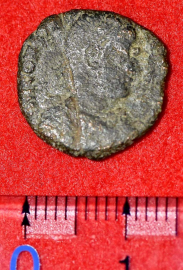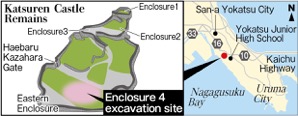Ancient Roman and Ottoman copper coins unearthed for the first time in Japan at Katsuren Castle, possibly from maritime trade

Copper coin discovered at the Katsuren Castle remains that appears to be from the Roman Empire. At a diameter of 1.6 cm, the image is presumed to be that of the Roman Emperor Constantine I
 September 27, 2016 Ryukyu Shimpo
September 27, 2016 Ryukyu Shimpo
[Uruma] Coins which appear to be from Roman Empire in the third and fourth centuries, as well as a coin from the Ottoman Empire in the 17th century, were unearthed at Katsuren Castle on September 26, according to the Uruma Board of Education (BoE). This excavation was the first of its kind from a Japanese historical site, and it is possible that the coins were brought to Japan via maritime trade in the 14th and 15th centuries. The BoE hopes that, “This discovery will be a great contribution to not only Japanese history, but also to the study of global trade as a whole.”
According to a number of archeologists who have analyzed the coins, this is the first time such an artifact from the Middle Ages to Early Modern period have been excavated from a historical site from the same period. The coins had Roman letters and Arabic letters respectively, as well as portraits of the emperors of the time.
The study was undertaken by the Uruma BoE with government funding from the Agency for Cultural Affairs. In December, 2013, excavation and analysis began in the eastern section of “Enclosure 4,” in the area around Katsuren Castle’s walls.
A total of 10 copper minted coins were found. Four of the coins were ascertained to be from the Roman Empire in the third to fourth century, and one was made by the Ottoman Empire sometime between 1669 and 1979. The five remaining coins are still being studied.
The coins from the Roman Empire have a diameter of 1.6 -2 cm, and weigh from 1.5-3.6 grams. They appear to be from 337 CE to around the middle of the fourth century, and x-rays have revealed the image of the Roman Emperor Constantine I. Meanwhile, the coin from the Ottoman Empire has a diameter of 2cm, and weighs 1.2 grams. Researchers confirmed that the back of the coin showed both the word for Istanbul and the year of issue. Porcelain as well as old coins from China and Southeast Asia in the 13th -14th centuries were also found around the excavation site.
Uruma BoE Director Masaki Yokoh stated, “It is clear that Katsuren Castle had connections with the West. There is still much we do not know about the history of the castle after it was deserted, and hopefully this precious finding will lead to further breakthroughs.”
The coins will be displayed at Uruma City Yonagusuku Historical Museum’s “New Discovery Exhibit” until November 25.
(English translation by T&CT and Sam Grieb)
Previous Article:Kings loses close game at B-League opening match
Next Article:Four years after Osprey deployment, some call for a stop to operations; others positive
[Similar Articles]
- 40th anniversary coin of Okinawa’s reversion will be issued with a full-color Shuri Castle design
- Students in Uruma perform the modern kumiodori play at the world heritage site Katsuren Castle
- Japan’s 100-yen coin gets a special Karate design commemorating the upcoming Tokyo Olympics
- Nansong coins, carved stone tools uncovered at Shuri Castle Ruins deemed valuable artifacts
- Cultural Affairs Council recommends two Okinawan sites to Minister of MEXT
 Webcam(Kokusai Street)
Webcam(Kokusai Street)


